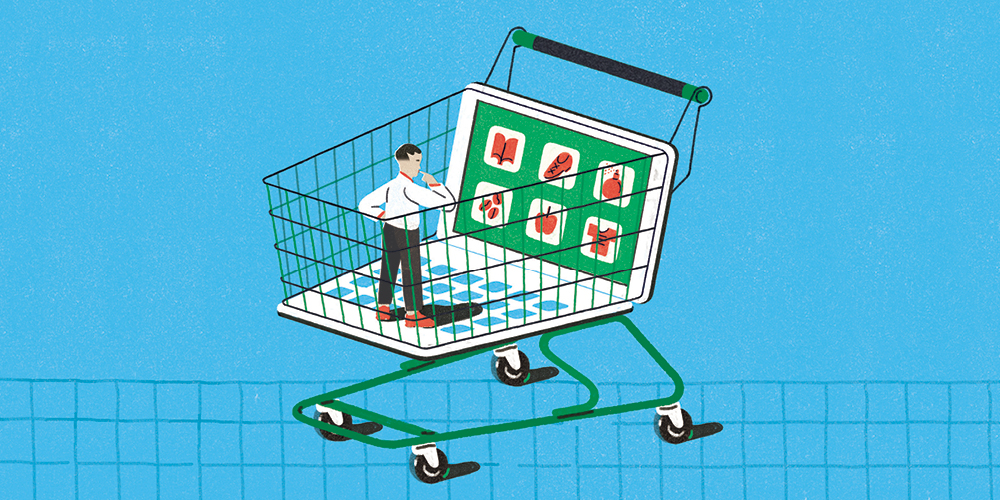Consumer companies must take leaps, not steps
As shoppers show how quickly they can adapt to external shocks, retailers will need to radically reconfigure their business models.
A version of this article appeared in the Winter 2020 issue of strategy+business.
Not long ago, most people went to work at a workplace — not in their basements or bedrooms. Homeschooling was a rarity. And buying groceries online was something relatively few shoppers were comfortable doing.
What a difference a few months can make. It turns out that people are much more open to change than businesses expected. They’ve rushed online to shop. They are experimenting freely to find what works best for them. And they are proving remarkably adept with technology tools. “During the pandemic, we’ve seen an unprecedented acceleration of trends that emerged over the past five years,” says Matthew Shay, president and CEO of the National Retail Federation. “Innovations are taking place in a matter of just months that would normally take years, in areas like acceleration of e-commerce offerings, blending of digital and in-store experiences, curbside pickup and quicker delivery options, and contactless delivery and payments.”
Consumers are not going back. “Post-pandemic, many of these changes may be here to stay,” Shay says. One data point: Almost 90 percent of online grocery shoppers plan to continue buying online when social-distancing measures are removed, according to PwC’s latest Global Consumer Insights Survey.
If you’re a consumer and retail business leader, you should be hearing an urgent signal in all of this: You must change at least as rapidly and profoundly as the shoppers you serve. You no longer have the luxury of applying tried-and-true transformation techniques. And simply setting up social distancing in the workplace or making tentative digitization moves won’t be enough. It’s time to radically rethink and reconfigure your business model for a perpetually uncertain future — or risk becoming obsolete.
Five ways to rethink and reconfigure your business
If you’re a consumer-facing company, you’re fortunate to be exposed to a constant stream of fresh insights into shoppers’ behaviors because the sales cycle is so short. But to transform quickly, you must identify and rapidly implement the changes that will provide the best chance of long-term growth. Making systemic change will help companies develop the resilience they’ll need to deal with the exogenous shocks that lie ahead, and will build the management muscles that promote agility and nonstop innovation.
Our research points to five ways in which you can begin to do this:
• Smooth out price oscillations as much as possible. The pandemic has played havoc with supply chains and spiked prices. The volatility couldn’t come at a worse time; PwC’s survey finds that 18 percent of consumers polled worldwide have experienced a loss of income and higher household bills. The challenge for you, then, is to use the many supply chain forecasting and price optimization tools at your disposal to minimize the price hikes as much as possible. Shoppers are likely to recognize and trust the businesses that show they’re doing a better job of consistently holding down prices. Not surprisingly, that spells good news for discount retailers everywhere.
• Help shoppers feel safe. We’ve seen that customers will select experiences that reinforce safety. For example, prospective guests at hotels and motels will demand to know about cleaning protocols. As a result, many hospitality venues now publicly state how long their rooms are left vacant between occupancies. Multiple retailers, such as Walmart, are requiring their employees and customers to wear masks in-store, even when there is no government regulation dictating it. Similarly, soon after the pandemic hit, Chipotle Mexican Grill partnered with Grubhub to expand its last-mile delivery, adding a seal to each meal package to assure customers it hadn’t been tampered with. Customers can also request contact-free delivery.
Levi Strauss now has curbside pickup at about 80 percent of its 200 or so stores in the United States. Best Buy is one of a number of large companies that have done the same. And Bacardi was quick to partner with U.K. food delivery firm Deliveroo to deliver cocktails at home — a move designed to also support local bars hard-hit by pandemic shutdowns.
• Reinforce shoppers’ embrace of digital. It’s clear that consumers will keep experimenting with newer channels, such as mobile and online grocery. PwC’s consumer survey shows how a steady movement toward e-shopping has suddenly accelerated. Before the pandemic, only about 9 percent of consumers bought their apples and avocados exclusively online. Now, 35 percent buy food online or by phone, and 63 percent of those consumers are buying more groceries online or by phone than before social distancing. Half of all consumers use social media more, and 56 percent watch television more than before social-distancing measures were put in place.
It’s time to radically rethink and reconfigure your business model for a perpetually uncertain future — or risk becoming obsolete.
With these trends in mind, Alibaba’s supermarket brand, Freshippo, has implemented self-service checkout kiosks, a mobile-first experience, and 30-minute product delivery. And since the start of the pandemic, U.S.-based automotive retailer AutoNation has accelerated a host of digital projects to keep up with customers’ needs. Its Store-to-Door offering — letting buyers find and purchase a car online and have it delivered to their home — was scheduled for rollout in 2021 but was launched in April 2020 instead. Meanwhile, behind the scenes, nimble retailers of all sorts are rapidly moving to cloud services to handle the upsurge in online sales as well as the ups and downs of today’s volatile markets.
Now is the time to accelerate long-anticipated 5G technology rollouts. Broadband networks have proved well able to handle the proliferation of video calls, and customers are clearly ready for more bandwidth.
• Do more to blend physical and digital experiences. Consumers still value physical locations for the sensory and social experiences they offer. In PwC’s Global Consumer Insights Survey, 49 percent of shoppers said their in-store shopping had increased or stayed the same since the onset of COVID-19. And consumers say they are willing to pay higher premiums for emotional connections. Although digital channels now offer the routes of least resistance — especially in times of social distancing and lockdowns — human interaction is still very important, especially in explaining products or services and finding the right solutions. Winter clothing manufacturer Canada Goose, for example, opened a concept store in Toronto that carries no inventory but mimics Arctic winter conditions so customers can try out down coats and make a purchase that arrives as soon as the same day. Alibaba partnered with Guess to offer customers at its Hong Kong concept store “mix and match” clothing recommendations based on their preferences, using a “smart” mirror, artificial intelligence, and other digital technologies. The mirror also suggests other products alongside customers’ selections, using their shopping history on the Taobao or Tmall platforms.
Brick-and-mortar stores do face challenges, though. Before COVID-19, in-store visits had long been city dwellers’ primary way to shop. PwC’s survey, pre-pandemic, showed that 47 percent of those surveyed shopped in-store at least once per week. That was then. Now, online shopping is increasing and foot traffic is falling. In the U.S., retail e-commerce sales in the second quarter of 2020 grewPDF by more than 44 percent year on year. And evidence of falling foot traffic is stark. For example, in June 2020, consumers shopped in person 50 percent less in Berlin, Hamburg, and Cologne, Germany, and 75 percent less in London’s West End than they did a year ago, according to German and British retailer associations.
• Prioritize what customers say they care about. Companies must transcend price, quality, and availability by prioritizing the intangibles that consumers care deeply about. PwC’s consumer survey confirms that. At no time in our 11 years of research have we seen such uniformity in consumers’ desires for transparency, sustainability, cleanliness, community living, and social consciousness.
Shoppers increasingly expect businesses to make sustainable, ethical choices that recognize stakeholders as much as shareholders, and that expectation has only increased since the onset of the pandemic. Before the pandemic, 43 percent of shoppers responding to PwC’s consumer survey said they expected businesses to be accountable for their environmental impact. In a separate, more recent consumer survey of U.S. residents, PwC found that 75 percent thought companies should try to maintain some of the unintended environmental benefits of the U.S. lockdown, such as reduced air pollution and cleaner water.
We believe that a year from now, the B2C landscape will look dramatically different. Big commerce platforms will have taken more share by leveraging strengths and driving down costs. AI and other emerging technologies will be adding more and more value. And people with disposable income will be paying even bigger premiums for amazing experiences. The trends supercharged by the pandemic are ones that PwC’s Global Consumer Insights Survey has been tracking for years. Those trends will only accelerate. We now need to plan for drone deliveries, mass personalization, completely cashless payments, and a renewed commitment to sustainability.
The headlines already point ahead: Many retailers are struggling to adapt to the sudden changes in consumer behavior brought about by the pandemic; for some, it will be the final straw. Yet others are acutely sensitive to consumer shifts and are demonstrating that they have the agility to respond swiftly to what they’re seeing. And new, innovative players — still unknown — will emerge to fill the gaps left by the B2C companies that have been unable to keep up.
Consumer-facing businesses just have to imagine what’s possible. Too few still lack the data insights and the supply chain flexibility to change course as quickly as consumers have shown they can. Too many businesses are still talking rather than acting. But the sooner you change, the faster your shareholders will recognize value.
Author profiles:
- Oz Ozturk is PwC’s global advisory consumer markets leader. He specializes in delivering large-scale, multi-geography technology programs for retail and consumer businesses, across all functions of the business. Based in London, he is a partner with PwC UK.
- Ian Kahn is a leading practitioner for PwC’s front-office transformation solutions practice. He has spent two decades helping brands transform customer relationship management capabilities in order to unlock new growth opportunities, enable better customer experiences, and realize productivity improvements. Based in New York, he is a principal with PwC US.





